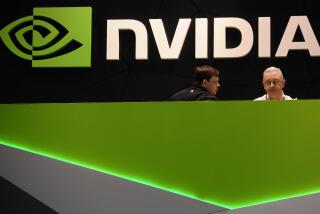If You Hop Aboard AMD, Remember to Buckle Up
- Share via
Jim: Don’t Buy
Mike: Buy
Advanced Micro Devices (AMD) Jim: Michael, we try to make it a point in this column to avoid Wall Street-speak as often as possible. Unfortunately, today I have to make an exception.
Mike: Uh-oh. Hang on while I put this Babelfish into my ear. Looks like I’m going to need a translation.
Jim: No, I’ll make this real simple. I’m going to throw out a word that you’re likely to hear a lot on CNBC. It’s “cyclicality.” It means there are some stocks so sensitive either to the economy or to conditions in their industry that they tend to soar and plunge with regularity, depending on how those conditions change.
Mike: And here I thought “cyclicality” was that stuff they banned from putting in soft drinks a few years ago.
Jim: I bring this up because I’m looking at a 10-year chart of the stock price of Advanced Micro Devices and, I must say, I’ve never seen a more stark illustration of cyclicality in my life. It looks like the Swiss Alps. It’s unbelievable how this stock has gone up and down and up and down.
Mike: So the question is . . . where in the cycle are we now?
Jim: Actually, I think I can answer that. In fact, if you look at the last 12 months of this stock, what does it look like? It looks like a volcano . . .
Mike: In the Swiss Alps?
Jim: . . . Because it soars in the first half of 2000 and then drops like a lead weight for the latter half of the year. So we now have a stock that’s trading in the mid-teens but, more startling, a tech stock that sells for just seven times its expected per-share earnings for 2000.
Mike: I think I can explain that fact.
Jim: Maybe first we ought to explain what this company does.
Mike: No sweat. You recall how 7-Up used to bill itself as the “Uncola”?
Jim: Right.
Mike: AMD is the “Un-Intel.” This company for decades has been Intel’s most dogged competitor in computer chips. Their relationship resembles, in my mind, that between England and Northern Ireland.
Jim: That’s quite apt.
Mike: In some horribly perverse way, they need each other, even though they hate each other. Now, AMD was founded to offer knockoffs of chips from Intel and a couple of other leading semiconductor companies. This was a boon for Intel customers.
Jim: And hence for consumers.
Mike: After all, if you’re a computer company, and you build your entire product line around Intel chips, what happens if Intel can’t deliver? The answer is, you buy from AMD.
Still, AMD pretty consistently failed to cut into Intel’s market share significantly until a couple of years ago, when AMD developed the K6 as a rival to Intel’s Pentium chip. That’s been a roaring success.
Jim: We should point out that what we’re talking about, primarily, are the microprocessors in a computer, the brains of your desktop computer. Today AMD also makes memory chips and microprocessors for devices such as cellular phones and high-end computers.
Mike: To finish the thought, these two companies are so closely linked that for a while it seemed that their only real business was suing each other and then signing multimillion-dollar settlements.
Let’s get back to that low AMD stock-price-to-earnings multiple. I believe one of the reasons for that low P/E is that this company has had one very colorful history. While it was getting its clock cleaned regularly by Intel, sometimes the only thing that kept the company going was the personality of its chairman and chief executive, W.J. “Jerry” Sanders III.
Jim: He’s a fixture of Silicon Valley. There’s no question about it.
Mike: Fixture? Yes, that’s a nice, nonjudgmental way of putting it.
Jim: The other thing we should mention is that these companies’ rivalry also produced waves and waves of price-cutting by both. It always had an effect on their bottom lines, which was especially unfortunate for AMD.
Mike: Sanders, who is nothing if not a great motivator, a couple of years ago gave a speech titled “Competing With an 800-Pound Gorilla.” Intel was a company with vast financial resources and could price-cut you into oblivion. Of course, Intel often did it by cannibalizing its own earnings, but it often had some to spare.
Jim: I’d suggest it has a lot less to spare these days.
Mike: Anyway, Intel’s dominance was why, for much of the ‘90s, AMD had no earnings. It was deep in a hole.
But I think it’s out of that hole now, and I see a number of positive developments.
Jim: Uh-oh. I hear a recommendation coming.
Mike: Sanders is in the process of turning over the management of AMD to a couple of pretty good successors, both from Motorola. The new president and presumed heir-apparent is Hector Ruiz. The new chief financial officer is Bob Rivet. It looks like they’re going to be presiding over a strong AMD product line.
The one concern that many investors have is that AMD is showing a tendency to get too big for its britches by offering chips for all these other devices. Many investors think it would be better off building on the success it has had with desktop PC chips.
Jim: Meaning the low-end PCs that you and I would buy for our home.
Mike: That’s right. Still, all things considered, at this price I think it might pay to take a flier on AMD.
Jim: That’s what it would be, all right, a speculative flier. I wouldn’t jump off that bridge with you. I’d avoid this stock.
AMD, along with Intel and Gateway and everyone else, has pointed out that the PC business is slowing. Actually, the brakes are burning. That’s how fast sales are slowing. Beyond that, I look at that stock chart again and I see AMD as a timing play, and right now the timing still looks bad. Fewer PC sales mean fewer chips, and it’s very hard to see when it will turn up.
Mike: But you want to get in before it turns up. AMD is about $16 today. It was $48 last summer.
Jim: And if the elevator man is still saying, “Going down?” This is a very difficult stock to hold as a long-term investment. Timing the general stock market is hard enough, but timing the semiconductor industry is even harder.
Mike: So now we’re on opposite sides of the same fence we shook hands over a week ago, when we talked about home-improvement retailer Lowe’s. You were ready to jump in and I called it a timing play.
Well, I agree that AMD is a timing play. Companies such as AMD--heck, all tech companies--are more likely to turn on a dime and to explode in valuation again when investors sense that the worst is over.
Jim: I agree that AMD’s valuation is quite compelling. But I’d still avoid it. I would much rather put my money in the likes of Corning and Qualcomm and some other tech names that I think have much stronger prospects.
Mike: But Qualcomm already has had a big run-up from its recent low. Sooner or later, investors are going to be looking for other beaten-down tech names to buy. And AMD--at this price--is a good place to start.
*
Write or e-mail with a stock you would like to see discussed in this column. Peltz ([email protected]) covers the markets and corporate financial trends. Hiltzik ([email protected]) covers technology and entertainment. Either can also be reached at Business Section, Los Angeles Times, 202 W. 1st St., Los Angeles, CA 90012.
More to Read
Inside the business of entertainment
The Wide Shot brings you news, analysis and insights on everything from streaming wars to production — and what it all means for the future.
You may occasionally receive promotional content from the Los Angeles Times.










